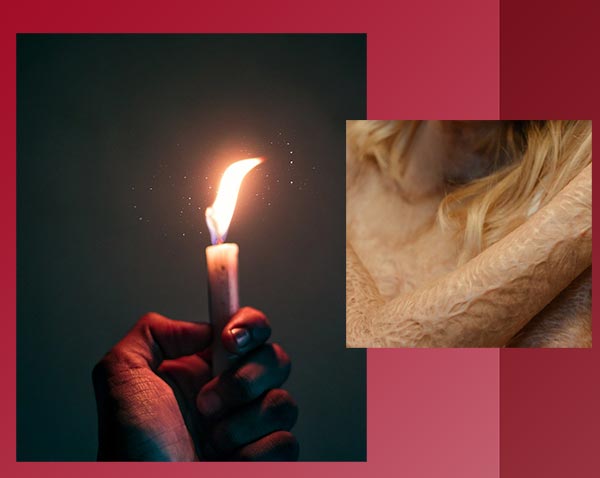What is a burn and what are the ways to treat burn?
Injuries that destroy skin tissue due to heat, electric shock, chemicals, and fire boiling waterjet are called burns.
Burns are one of the problems that probably happened to everyone.
During your life, from childhood to adulthood, you have experienced a burn once.
Burns caused by boiling water or fire cause very destructive effects on skin tissue.
Burns are known as the second cause of death among children, an adolescent, and adults.
Children are more likely to get burned with boiling water due to their curiosity.
After a burn, complete treatment should be done on the skin so that the skin is repaired and less burn marks remain.

Types of Burns:
1-first degree burn
2-second degree burn
3-Third degree burn
First Degree Burn
In first-degree burns or superficial burns the color of the skin becomes a red dot to burns of the epidermis.
Pain, and redness, in Flammarion, are symptoms of superficial burns.
In first-degree burns, because the skin is less damaged the recovery period is less than 10 days, and no scars.
First-Degree Burn Treatment
Place the burn under cold water for 5-7 minutes.
Wash the burn area with washing serum and combine equal amounts of burn ointment and antibiotic ointment and add some lidocaine ointment to it a and put it on the burn area and bandage the burn wound.
Use medications such as acetaminophen and ibuprofen every 8 hours to prevent pain from burns.
Second Degree Burn
In second-degree burns, more damage is to the skin around the skin.
Second-degree burn is more serious than first-degree burn and requires immediate treatment.
In this type of burn, the epidermis and dermis are more damaged.
Second-degree burn treatment lasts more than three weeks.
A second-degree burn is very painful due to its size, this type of burn causes in Flammarion and serious infections in the body.
Factors such as sun, heat, boiling water, gas stove, chemicals, and thermal an adhesive cause second-degree burns.
Symptoms of Second-Degree Burn
1-Blisters are visible on the skin
2-The color of the red skin becomes dark
3-Pain and swelling are more in tense
4-Skin layers are removed
Note that if the burn site is larger than 8 cm or there is weakness in the burned parts of the body and the burn sites in factious and you have symptoms of fever, go to the burn accident hospital immediately.
Children and elderly people or people with special diseases need to receive medical services when burned.
The degree of burn can be determined by the appearance of the burn if the burn area is only red, it is a first-degree burn, but if blisters form on the burn area, it is a second-degree burn.
Treatment of Second-Degree Burns:
Place the burn under cold water for 10-20 minutes and then wash the burn area with serum and dry it with sterile gauze combine the burn ointment (silver) with mupirocin ointment and Vitamin AD ointment in equal amounts and add some lidocaine ointment and apply this combination medicine slowly on the burn area.
Tip: Do not touch the blisters on the skin because it increases the infection at the burn site.
For quick healing, cover the burn area with sterile Vaseline gauze and fix it with a lace bandage pay attention that the dressing is not tight.
To prevent infection, change the dressing every day in the burn area, apply a combined ointment on the wound, and bandage it.
Third-degree Burn:
Third-degree burn due to the severity and depth of the burn, there is no pain in the burned area. Because all three layers of the skin including the epidermis, sebaceous, glands, hair follicles, and nerves of the body have been severely damaged.
Third-degree burn is the most severe type of burn and causes the most damage to the nerves.
Symptoms of third-degree burn:
Every person may have different symptoms of third-degree burns, but the main symptoms of third-degree burns are:
1-The skin becomes dry
2-The color of the skin changes to white or yellow, dark brown.
3-swelling and inflammation
4- due to the loss of nerves
5-not felt in the burn area Blister.
Third-degree burns have a longer recovery period than first- and second-degree burns.
A person who suffers a third-degree burn should immediately go to the accident and burn hospital so that the treatment can start sooner In third-degree burns, the patient’s age and medical history, drug.
Sensitivity, burn location, extent g burn and type of burn, and type of burn are checked by the doctor so that the best treatment can be started for you.
Third-degree Burn Treatment
first, they clean the burn area and remove the dead skin from the burned area this procedure is performed in the hospital by a nurse or doctor.
Give the patient liquids containing electrolytes (serum therapy).
In case of infection, it is better to receive intravenous antibiotics lubricate the burn site with burn ointment (silver) and antibiotic and Vitamin AD ointment, and cover the burn site with sterile Vaseline gauze to prevent the entry of germs and bacteria.
The diet of a person who has a third-degree burn should contain protein and collagen.
Tetanus vaccine is mandatory for third-degree burns.
Skin grafting is done to the damaged area if needed.
Joints and muscles that fret third-degree burns do not have the necessary ability as before.
It is better to perform physiotherapy after the burn has completely recovered.
Leave a Reply